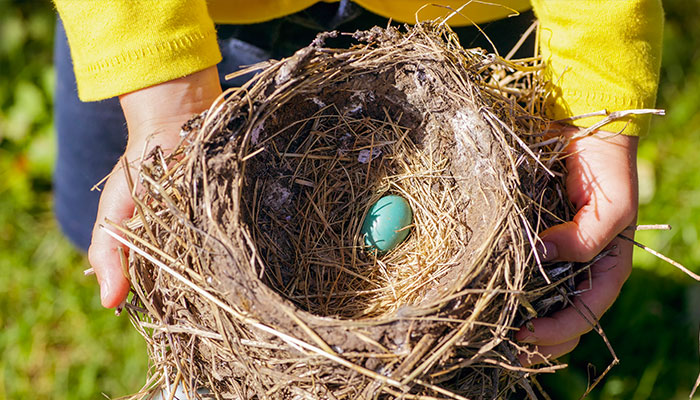While we believe that the books and resources recommended may be of value to you, keep in mind that these are suggestions only and you must do your own due diligence to determine whether the materials are appropriate and suitable for your use. PNC has no sponsorship or endorsement agreement with the authors or publishers of the materials listed.
SPRING

Bird Nesting Balls
Children will assemble materials that birds use in making their nests.

Lesson Objective
The children will learn that birds gather many materials to make their nests in the spring.
Science
What You'll Need
- 2 or 3 birds’ nests that you have saved from the fall (if possible), or pictures of birds’ nests
- Mesh vegetable bags (e.g., plastic netting from around onions) – 1 per child
- Leftover thread, yarn pieces, fabric scraps, raffia, tissues, cotton balls – enough for the class
- Large rubber bands – 1 per child
- Long pieces of yarn – 1 per child
- Disposable gloves – for teachers and children if handling bird nests
- Chart paper
- Markers
What To Do
- Discuss background knowledge about birds and what birds build nests from.
- Display the nests (see Lesson Tips) or pictures of nests and talk about what materials birds can use to build their nests (see Did You Know?).
- Provide each child with a mesh bag and ask them to fill it with any of the available materials (e.g., thread, yarn). Say, “Think about what we have observed from our nests [or pictures] when you are choosing what to add to your bag.”
- Pull the mesh together around the items.
- Take a rubber band and wrap it around the open end of the bag.
- Thread a long piece of yarn through the mesh and tie the ends of the yarn together to make a hanger. These creations are called nesting balls.
- Hang the nesting balls in a tree high enough where the birds feel safe.
- Over the next few weeks, have the children observe what materials have been removed from the nesting balls. Also look to see if any nests have familiar materials in them.
Resources
Home School Resources
Home educators: use these printable lesson PDFs to teach this lesson to your home schoolers. They're available in English and Spanish.
Content Provided By
Common Core State Standards Initiative – These lessons are aligned with the Common Core State Standards ("CCSS"). The CCSS provide a consistent, clear understanding of the concepts and skills children are expected to learn and guide teachers to provide their students with opportunities to gain these important skills and foundational knowledge [1]. Visit the CCSS


